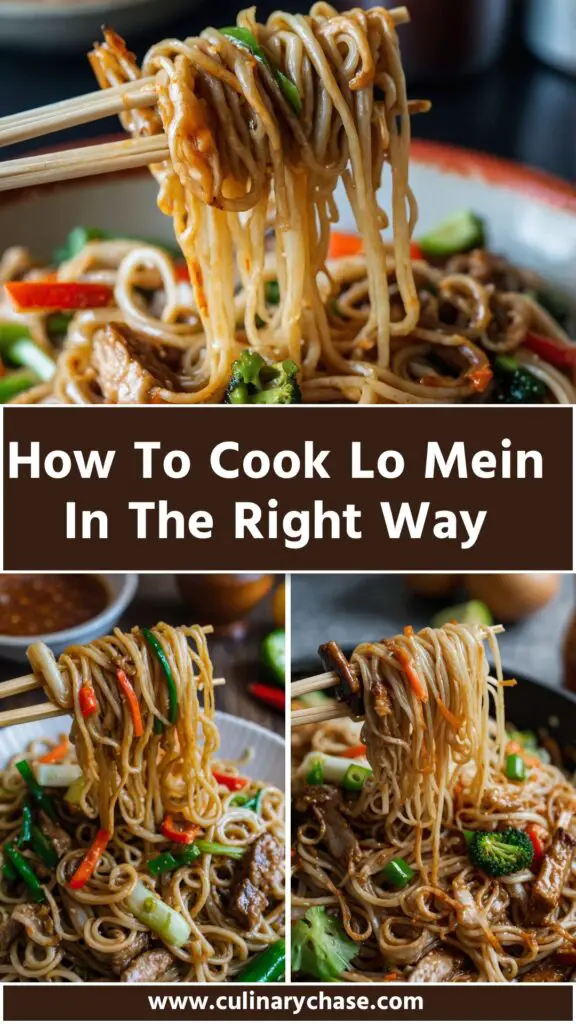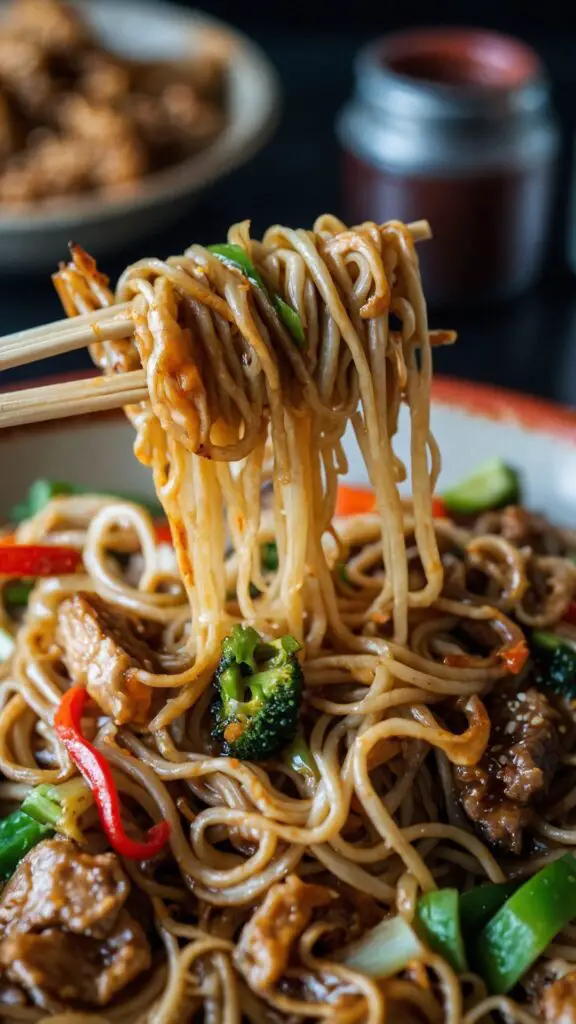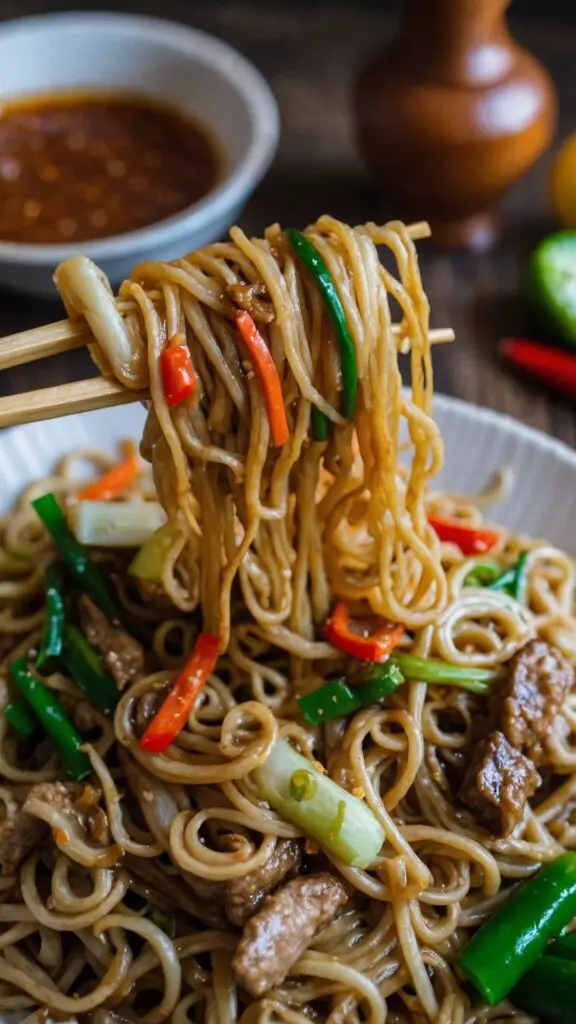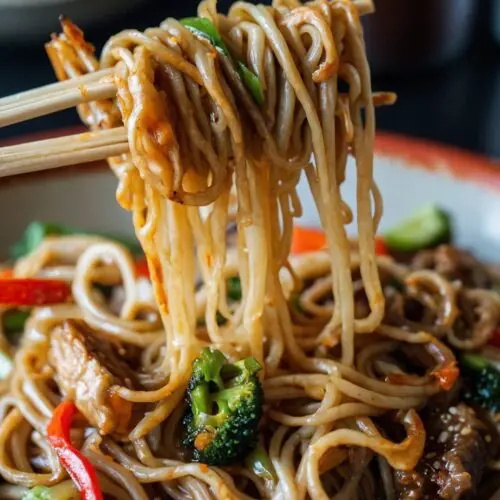How To Cook Lo Mein In The Right Way – Culinary Chase
Lo Mein pairs wonderfully with crispy egg rolls that add a crunchy texture to the tender noodles. Their flavorful filling provides a satisfying contrast, making each bite more exciting.
Light and refreshing spring rolls are another great choice. Packed with colorful veggies, they complement the Lo Mein without overpowering its savory taste, keeping the meal balanced.
For a protein boost, sweet and sour chicken is a classic side. Its sweet tanginess pairs perfectly with the rich flavors of Lo Mein, adding a delicious zing to your plate.
Tender Chinese ribs also make an indulgent pairing. Their hearty, succulent meat balances the noodles, creating a satisfying and filling meal experience.

I remember the first time I fell in love with Lo Mein. A rainy evening, an old Chinese takeout menu, and a heartfelt desire for comfort food pushed me to explore. Lo Mein, with its tender noodles and vibrant veggies, beckoned me.
I decided it was time to master this dish in my own kitchen. Cooking Lo Mein at home isn’t just about following a recipe; it’s about creating a meal infused with warmth and flavor. Let me show you how I found the sweet spot between convenience and deliciousness.
What is Lo Mein?
Lo Mein is a Chinese noodle dish that features wheat flour noodles tossed with vegetables and a protein of your choice.
Traditionally, it is seasoned with savory sauces, making it a flavorful dish that can satisfy in so many ways. The noodles are soft and chewy, soaking up all the flavors around them.
What Does It Taste Like?
Imagine a medley of textures and flavors. You get the softness of the noodles, the crunchy freshness of the vegetables, and the savory notes from the sauces.
Each bite offers a harmony of umami, slight sweetness, and a hint of spice, making it an unforgettable experience.
You will also like the following Lunch and Dinner recipes!
Why This Recipe Works
Why should you trust this recipe? Let’s break down the reasons:
– Quality Ingredients: Quality makes all the difference. Fresh vegetables and a well-chosen protein create a flavorful foundation. Using real oyster sauce and soy sauces enhances the dish’s authenticity.
– Balance of Flavors: The combination of salty, sweet, and umami from the sauces creates a complex taste that will keep your palate dancing.
– Flexibility: One of the best features of Lo Mein is its versatility. You can customize it based on what you have available or what flavors you prefer.
– Quick Preparation: This dish comes together in a flash. With all the ingredients prepped, you’ll have a satisfying and nutritious meal in around 30 minutes.
Ingredients for How to Cook Lo Mein in the Right Way
To whip up a stellar Lo Mein, you’ll need the following:
- 1 pound fresh lo mein noodles (either pre-cooked or uncooked)
- 12 ounces raw velveted protein (thinly sliced chicken, beef, pork, or shrimp; or 8 ounces/225g pre-cooked sliced or julienned protein)
- 2 tablespoons neutral cooking oil (vegetable, canola, peanut, or avocado oil)
- 2 cloves garlic (finely minced)
- 1 cup fresh shiitake mushrooms (thinly sliced)
- ¾ cup julienned carrots
- ½ cup bamboo shoots (thinly sliced)
- 3½ cups napa cabbage (finely shredded)
- 1 cup snow peas (trimmed)
- 2½ cups mung bean sprouts
- 2 tablespoons hot chicken broth or water
- 1½ tablespoons oyster sauce
- 1½ tablespoons light soy sauce
- 1 tablespoon dark soy sauce
- ½ teaspoon kosher salt (or to taste)
- ¼ teaspoon granulated sugar
- ⅛ teaspoon ground white pepper
- ½ teaspoon toasted sesame oil
- 1 tablespoon Shaoxing rice wine
- 2 scallions (thinly julienned)
- 1 teaspoon grated fresh ginger
- 1 teaspoon chili garlic sauce

Step By Step Instructions
Step 1: Prepare the Noodles
Start by cooking your lo mein noodles. If they are fresh, boil them for 2 to 3 minutes until they’re tender but still firm. If they are dried, follow the package instructions. Rinse with cold water once done and set them aside. This will keep them from sticking together.
Step 2: Velvet the Protein
If you’re using raw protein, treat it with the velvet technique—this involves marinating the protein in a mixture of water, cornstarch, and soy sauce.
This process tenderizes the meat and enhances flavor. If using pre-cooked protein, just slice it thinly and prepare to add it directly to the pan.
Step 3: Sauté the Aromatics
Heat your neutral cooking oil in a large skillet or wok over medium-high heat. Once hot, add minced garlic and ginger. Sauté them until fragrant—this usually takes about 30 seconds. Their aroma fills the kitchen; it’s the first step to a delicious meal.
Step 4: Cook the Protein
Introduce your marinated protein into the hot skillet. Stir-fry it until fully cooked, about 5 minutes for chicken or shrimp. You want nice browning, which adds depth to the final dish.
Step 5: Add the Veggies
Toss in the shiitake mushrooms, carrots, snow peas, bamboo shoots, and napa cabbage. Stir-fry these colorful vegetables until they’re just tender, about 3 to 5 minutes. This quick cooking keeps them crisp, adding texture to your dish.
Step 6: Combine Everything
Add your cooked lo mein noodles to the skillet.
Pour in the hot chicken broth or water, oyster sauce, light and dark soy sauces, salt, sugar, white pepper, sesame oil, and Shaoxing rice wine. Use tongs or chopsticks to toss everything together well and warm through—around 2 minutes.
Step 7: Finish with Freshness
Finally, add the mung bean sprouts and scallions. These fresh ingredients brighten up the dish, making it vibrant. Stir just until combined, then serve.
Notes
Here are some tips to ensure that your Lo Mein comes out perfectly:
– Don’t Overcook the Noodles: They should be al dente as they will cook further in the pan when combined with the sauce.
– Use High Heat: A hot skillet/wok will help to sear the ingredients, creating flavor.
– Prep Your Ingredients First: Unsurprisingly, Lo Mein cooks quickly. Having everything chopped and ready makes all the difference.
– Taste as You Go: Adjust the seasoning based on your preferences. Each soy sauce and oyster sauce can vary.
– Cook in Batches: If you have a small skillet, cook the protein and vegetables in batches to avoid overcrowding, ensuring everything cooks evenly.
Nutrition Information
How To Cook Lo Mein In The Right Way Nutrition Facts
How To Store The Leftovers?
Leftovers can be a lifesaver for busy days. After cooking, allow your Lo Mein to cool down to room temperature, then transfer it to an airtight container.
Refrigerate for up to 3 days. When you’re ready to enjoy it again, simply heat it in a skillet or the microwave briefly until warmed through. You may need to add a splash of water or broth to prevent it from drying out.

Sides for How To Cook Lo Mein in the Right Way
A well-rounded meal is always pleasing. Here are some delightful sides to consider:
– Hot and Sour Soup: This classic soup contrasts beautifully with the savory Lo Mein and provides warmth and spice.
– Crispy Fried Tofu: Firm tofu with a crisp exterior elevates your meal, adding protein and texture.
– Asian Pickled Vegetables: Tangy and crunchy, they provide a great counterpoint to the richness of Lo Mein.
– Steamed Edamame: Simple and healthy, these little beans pack a protein punch without overwhelming the palate.
Alternative Choices for Ingredients
Don’t have everything on hand? Here are alternatives to keep the dish alive:
– Noodles: You can swap lo mein noodles for spaghetti or even rice noodles. They will cook a bit differently, so adjust timing accordingly.
– Protein: If you don’t have chicken, beef, or shrimp, try adding firm tofu or tempeh as great vegetarian options.
– Vegetables: Zucchini, bell peppers, or broccoli can replace the veggies. Just adjust cooking times as needed.
– Sauces: If oyster sauce isn’t available, a mix of soy sauce and hoisin sauce can mimic that deep flavor.

How To Cook Lo Mein In The Right Way
Equipment
- Skillet
Ingredients
- 1 pound fresh lo mein noodles either pre-cooked or uncooked
- 12 ounces raw velveted protein thinly sliced chicken, beef, pork, or shrimp; or 8 ounces/225g pre-cooked sliced or julienned protein
- 2 tablespoons neutral cooking oil vegetable, canola, peanut, or avocado oil
- 2 cloves garlic finely minced
- 1 cup fresh shiitake mushrooms thinly sliced
- ¾ cup julienned carrots
- ½ cup bamboo shoots thinly sliced
- 3½ cups napa cabbage finely shredded
- 1 cup snow peas trimmed
- 2½ cups mung bean sprouts
- 2 tablespoons hot chicken broth or water
- 1½ tablespoons oyster sauce
- 1½ tablespoons light soy sauce
- 1 tablespoon dark soy sauce
- ½ teaspoon kosher salt or to taste
- ¼ teaspoon granulated sugar
- ⅛ teaspoon ground white pepper
- ½ teaspoon toasted sesame oil
- 1 tablespoon Shaoxing rice wine
- 2 scallions thinly julienned
- 1 teaspoon grated fresh ginger
- 1 teaspoon chili garlic sauce
Instructions
Step 1: Prepare the Noodles
- Start by cooking your lo mein noodles. If they are fresh, boil them for 2 to 3 minutes until they’re tender but still firm. If they are dried, follow the package instructions. Rinse with cold water once done and set them aside. This will keep them from sticking together.
Step 2: Velvet the Protein
- If you’re using raw protein, treat it with the velvet technique—this involves marinating the protein in a mixture of water, cornstarch, and soy sauce.
- This process tenderizes the meat and enhances flavor. If using pre-cooked protein, just slice it thinly and prepare to add it directly to the pan.
Step 3: Sauté the Aromatics
- Heat your neutral cooking oil in a large skillet or wok over medium-high heat. Once hot, add minced garlic and ginger. Sauté them until fragrant—this usually takes about 30 seconds. Their aroma fills the kitchen; it’s the first step to a delicious meal.
Step 4: Cook the Protein
- Introduce your marinated protein into the hot skillet. Stir-fry it until fully cooked, about 5 minutes for chicken or shrimp. You want nice browning, which adds depth to the final dish.
Step 5: Add the Veggies
- Toss in the shiitake mushrooms, carrots, snow peas, bamboo shoots, and napa cabbage. Stir-fry these colorful vegetables until they’re just tender, about 3 to 5 minutes. This quick cooking keeps them crisp, adding texture to your dish.
Step 6: Combine Everything
- Add your cooked lo mein noodles to the skillet.
- Pour in the hot chicken broth or water, oyster sauce, light and dark soy sauces, salt, sugar, white pepper, sesame oil, and Shaoxing rice wine. Use tongs or chopsticks to toss everything together well and warm through—around 2 minutes.
Step 7: Finish with Freshness
- Finally, add the mung bean sprouts and scallions. These fresh ingredients brighten up the dish, making it vibrant. Stir just until combined, then serve.
Notes
- Don’t Overcook the Noodles: They should be al dente as they will cook further in the pan when combined with the sauce.
- Use High Heat: A hot skillet/wok will help to sear the ingredients, creating flavor.
- Prep Your Ingredients First: Unsurprisingly, Lo Mein cooks quickly. Having everything chopped and ready makes all the difference.
- Taste You Go: Adjust the seasoning based on your preferences. Each soy sauce and oyster sauce can vary.
- Cook in Batches: If you have a small skillet, cook the protein and vegetables in batches to avoid overcrowding, ensuring everything cooks evenly.
Nutrition
Frequently Asked Questions
1. Can I make Lo Mein vegetarian?
Absolutely! Just replace any protein with tofu or more vegetables. This dish is versatile and can adapt easily to your dietary preferences.
2. What’s the difference between Lo Mein and Chow Mein?
The primary difference is in the noodles and cooking method. Lo Mein noodles are soft and boiled, while Chow Mein has crispy, stir-fried noodles. It often has a crunchier texture.
3. Can I use frozen veggies?
Definitely! Frozen vegetables can save prep time. Just add them directly to the pan. They may release some moisture when cooking, so watch the sauce consistency.
4. How spicy is this dish?
The spice level can be adjusted based on your preference. The chili garlic sauce can be omitted or used sparingly if you prefer a milder flavor.
Conclusion
Cooking Lo Mein at home can be a fun and rewarding experience. With fresh ingredients and your own personal touch, you can elevate this take-out favorite to new heights. Whether you’re preparing a cozy meal for yourself or a feast for friends, this dish brings joy to the table.
Embrace the flavors and enjoy the process. After all, cooking is about sharing experiences through food. Fill your kitchen with the wonderful aroma of your homemade Lo Mein, and let the good times roll!
